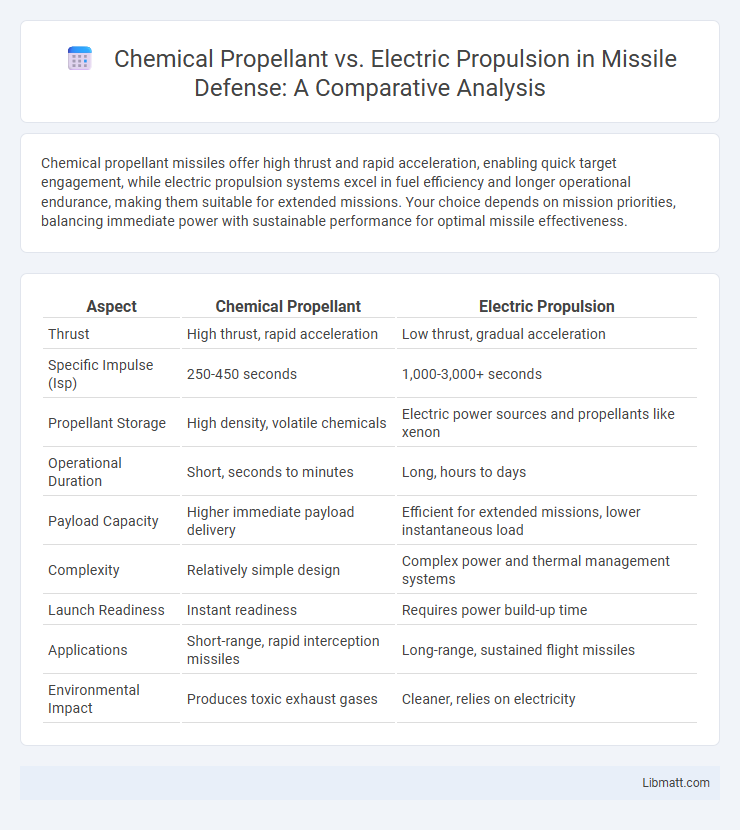Chemical propellant missiles offer high thrust and rapid acceleration, enabling quick target engagement, while electric propulsion systems excel in fuel efficiency and longer operational endurance, making them suitable for extended missions. Your choice depends on mission priorities, balancing immediate power with sustainable performance for optimal missile effectiveness.
Table of Comparison
| Aspect | Chemical Propellant | Electric Propulsion |
|---|---|---|
| Thrust | High thrust, rapid acceleration | Low thrust, gradual acceleration |
| Specific Impulse (Isp) | 250-450 seconds | 1,000-3,000+ seconds |
| Propellant Storage | High density, volatile chemicals | Electric power sources and propellants like xenon |
| Operational Duration | Short, seconds to minutes | Long, hours to days |
| Payload Capacity | Higher immediate payload delivery | Efficient for extended missions, lower instantaneous load |
| Complexity | Relatively simple design | Complex power and thermal management systems |
| Launch Readiness | Instant readiness | Requires power build-up time |
| Applications | Short-range, rapid interception missiles | Long-range, sustained flight missiles |
| Environmental Impact | Produces toxic exhaust gases | Cleaner, relies on electricity |
Introduction to Missile Propulsion Technologies
Missile propulsion technologies are primarily divided into chemical propellants and electric propulsion systems, each offering distinct performance characteristics. Chemical propellants deliver high thrust through rapid combustion, enabling quick acceleration and powerful launches ideal for short-range tactical missiles. Electric propulsion, using ionized gases accelerated by electromagnetic fields, provides higher efficiency and longer endurance, benefiting strategic or space-based missile applications where extended operation is crucial.
Overview of Chemical Propellant Systems
Chemical propellant systems in missile technology rely on the rapid combustion of fuel and oxidizer to generate high-pressure gases for thrust, enabling quick acceleration and high thrust-to-weight ratios. These systems typically use solid or liquid propellants, with solid propellants offering simplicity and storability, while liquid propellants provide controlled thrust and higher specific impulse. Their established reliability and energy density make chemical propulsion ideal for short-duration, high-power missile launches despite lower efficiency compared to electric propulsion systems.
Fundamentals of Electric Propulsion for Missiles
Electric propulsion for missiles relies on accelerating ions or plasma using electric fields, achieving higher specific impulse compared to traditional chemical propellants. This technology utilizes components such as ion thrusters, Hall effect thrusters, and pulsed plasma thrusters to efficiently convert electrical energy into thrust, significantly reducing propellant mass and extending range. The fundamentals emphasize ionization methods, ion acceleration, and plasma containment, which enable enhanced maneuverability and longer mission durations in missile applications.
Thrust and Efficiency Comparison
Chemical propellant missiles generate significantly higher thrust, enabling rapid acceleration and immediate response in short-range engagements. Electric propulsion systems offer superior efficiency with higher specific impulse, allowing longer operational duration and optimized fuel consumption for strategic missile missions. Your choice depends on mission requirements, balancing the need for initial thrust against overall propulsion efficiency.
Energy Density and Storage Challenges
Chemical propellants offer high energy density, enabling missiles to achieve powerful thrust and rapid acceleration, but they require complex storage solutions to handle volatile and hazardous materials safely. Electric propulsion systems, while possessing significantly lower energy density compared to chemical propellants, benefit from safer, more compact energy storage such as batteries or capacitors, yet they currently face challenges in providing the high thrust levels needed for missile applications. Your choice between these propulsion types involves balancing the superior immediate energy release of chemical propellants against the safer, more manageable storage and efficiency of electric propulsion for sustained thrust.
Impact on Missile Range and Speed
Chemical propellant missiles generate high thrust through rapid combustion, enabling greater initial acceleration and higher speeds, which directly extend their effective range. Electric propulsion systems provide continuous, efficient thrust over longer durations but yield lower acceleration, resulting in slower speeds and often limited range compared to chemical counterparts. Your choice between these propulsion types depends on mission priorities, balancing swift target engagement against prolonged endurance.
Guidance, Control, and Maneuverability
Chemical propellant missiles typically offer higher thrust levels, enabling rapid acceleration and quick response in guidance and control systems, which enhances agility during flight maneuvers. Electric propulsion provides more precise thrust modulation with lower but continuous force, improving fine control and extended maneuverability over longer durations. Your choice between these propulsion methods impacts missile responsiveness, with chemical systems favoring aggressive, swift target engagement and electric systems excelling in sustained course adjustments.
Operational Reliability and Maintenance
Chemical propellant missiles offer high operational reliability due to their mature technology and simple storage requirements, ensuring rapid deployment with minimal maintenance. Electric propulsion systems, while providing advantages in maneuverability and fuel efficiency, demand more complex maintenance protocols and are currently less proven in high-stress operational environments. Your choice between the two should consider the trade-off between established reliability and the evolving potential of electric propulsion for specific mission needs.
Environmental and Safety Considerations
Chemical propellants in missiles often pose significant environmental hazards due to the release of toxic combustion byproducts and the challenges associated with storage and handling of volatile substances. Electric propulsion offers a cleaner alternative with lower emissions and reduced risk of accidental explosions or leaks, enhancing overall missile safety and environmental compatibility. Incorporating electric propulsion technology can improve your missile system's sustainability while minimizing ecological and operational risks.
Future Trends in Missile Propulsion Technologies
Advancements in missile propulsion are increasingly favoring electric propulsion systems due to their higher efficiency, longer operational lifespans, and precise thrust control compared to traditional chemical propellants. Future trends indicate a shift toward hybrid propulsion technologies that combine the rapid thrust of chemical propellants with the sustained efficiency of electric propulsion, enhancing missile range and maneuverability. You can expect ongoing research to optimize energy storage and power management in electric systems, driving more sustainable and effective missile performance.
chemical propellant vs electric propulsion (missiles) Infographic

 libmatt.com
libmatt.com